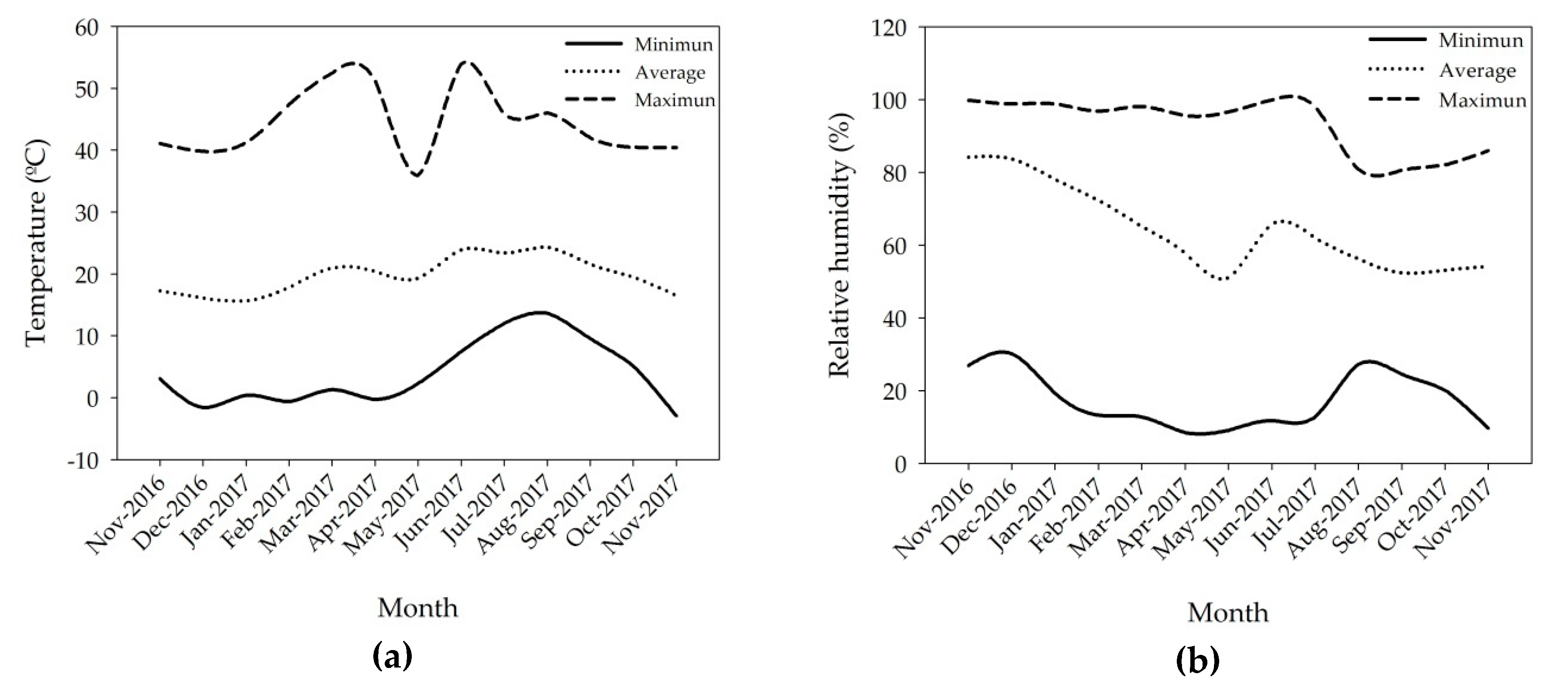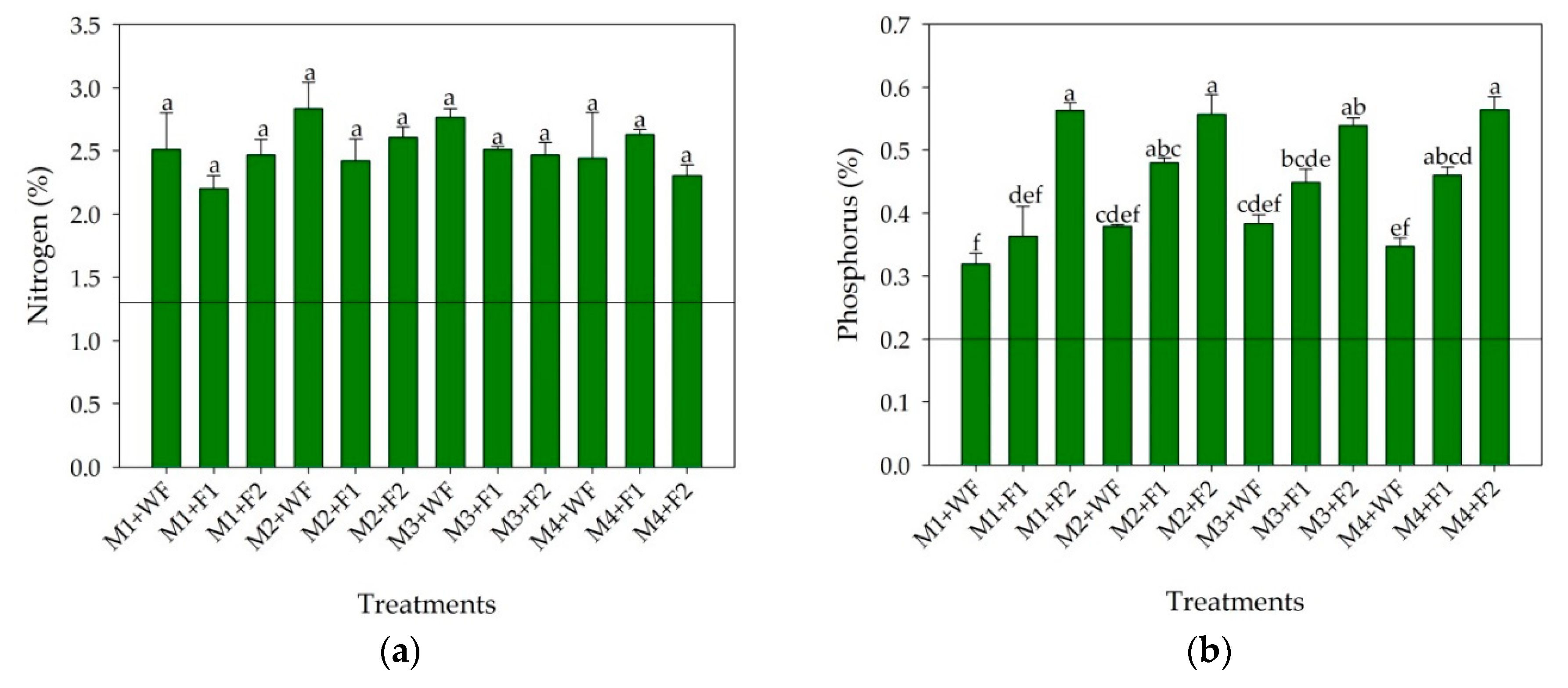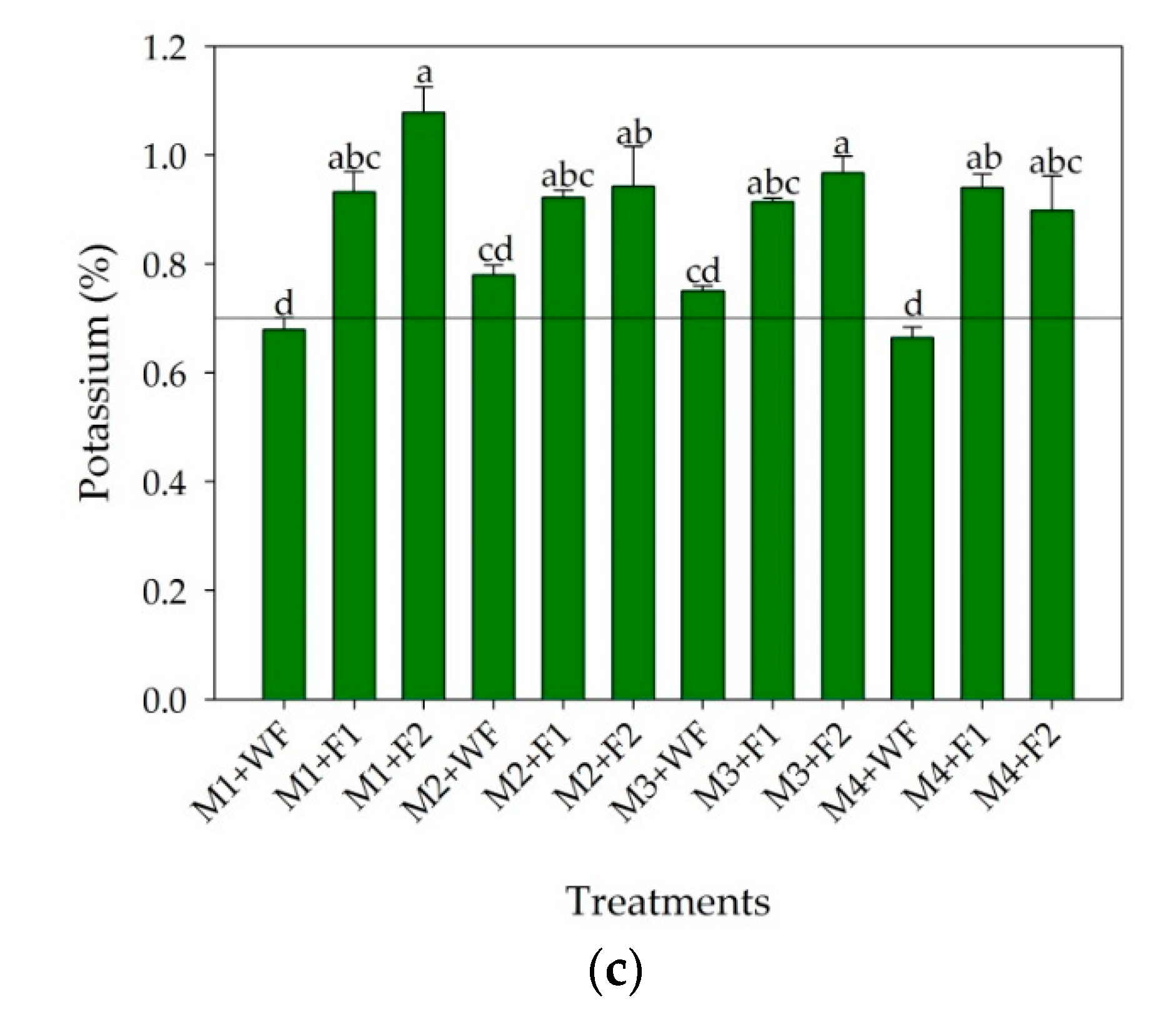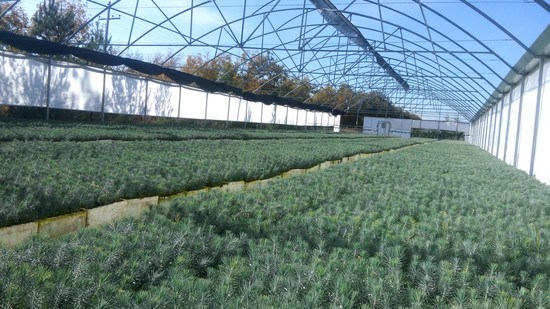Alternative Substrates and Fertilization Doses in the Production of Pinus cembroides Zucc. in Nursery
Abstract
1. Introduction
2. Materials and Methods
2.1. Study Site
2.2. Establishment of the Experiment
2.3. Treatments
2.4. Experimental Design
2.5. Measured Variables
2.6. Statistical Analyses
3. Results
3.1. Physical Characteristics of Substrate Mixtures
3.2. Morphological Characteristics and Quality Index
3.3. Concentration of N, P and K in the Foliage
4. Discussion
4.1. Morphological Characteristics and Quality Index
4.2. Nutrition
5. Conclusions
Author Contributions
Acknowledgments
Conflicts of Interest
References
- Comisión Nacional Para el Conocimiento y Uso de la Biodiversidad. Capital Natural y Bienestar Social. 2006. Available online: http://www.conabio.gob.mx/2ep/images/3/37/capital_natural_2EP.pdf (accessed on 30 March 2019).
- Mora, D.C.A.; Alanís, R.E. Resiliencia de bosques de pino–encino en América: Una visión global del estado actual. Kurú 2016, 13, 1–2. [Google Scholar] [CrossRef]
- Comisión Nacional Forestal. Número de Plantas Establecidas en Áreas Reforestadas. 2018. Available online: http://dgeiawf.semarnat.gob.mx:8080/approot/dgeia_mce/html/mce_index.html (accessed on 30 March 2019).
- Muñoz, F.H.J.; Sáenz, R.J.T.; Coria, A.V.M.; García, M.J.J.; Hernández, R.J.; Manzanilla, Q.G.E. Plant quality in the La Dieta forest nursery in Zitácuaro municipality, Michoacán state. Rev. Mex. Cienc. For. 2014, 6, 72–89. Available online: http://www.scielo.org.mx/scielo.php?script=sci_arttext&pid=S2007-11322015000100007&lng=es&tlng=es (accessed on 10 April 2019).
- Burney, O.; Aldrete, A.; Alvarez, R.R.; Prieto, R.J.A.; Sánchez, V.J.R.; Mexal, J.G. México-Addressing Challenges to Reforestation. J. For. 2015, 113, 404–413. [Google Scholar] [CrossRef]
- Dumroese, R.K.; Landis, T.D.; Pinto, J.R.; Haase, D.L.; Wilkinson, K.W.; Davis, A.S. Meeting forest restoration challenges: Using the target plant concept. Reforesta 2016, 1, 37–52. Available online: https://www.fs.fed.us/rm/pubs_journals/2016/rmrs_2016_dumroese_k001.pdf (accessed on 10 April 2019). [CrossRef]
- Grossnickle, S.C. Why seedlings survive: Influence of plant attributes. New For. 2012, 43, 711–738. [Google Scholar] [CrossRef]
- Jacobs, D.F.; Salifu, K.F.; Seifert, J.R. Relative contribution of initial root and shoot morphology in predicting field performance of hardwood seedlings. New For. 2005, 30, 235–251. [Google Scholar] [CrossRef]
- Riikonen, J.; Luoranen, J. Seedling Production and the Field Performance of Seedlings. Forests 2018, 9, 740. [Google Scholar] [CrossRef]
- Davis, A.S.; Jacobs, D.F. Quantifying root system quality of nursery seedlings and relationship to outplanting performance. New For. 2005, 30, 295–311. [Google Scholar] [CrossRef]
- Rose, R.; Haase, D.L.; Arellano, E. Controlled-release fertilizers: Potential for enhanced reforestation productivity. Bosque 2004, 25, 89–100. [Google Scholar] [CrossRef][Green Version]
- Dickson, A.; Leaf, A.; Hosner, J. Quality appraisal of white spruce and white pine seedlings stock in nurseries. For. Chron. 1960, 36, 10–13. Available online: https://pubs.cif-ifc.org/doi/pdf/10.5558/tfc36010-1 (accessed on 30 March 2019). [CrossRef]
- Tsakaldimi, M.; Ganastsas, P.; Jacobs, D.F. Prediction of planted seedling survival of five Mediterranean species base on initial seedling morphology. New For. 2013, 44, 327–339. [Google Scholar] [CrossRef]
- Shalizi, M.N.; Goldfarb, B.; Burney, O.T.; Shear, T.H. Effects of five growing media and two fertilizer levels on polybag—Raised Camden whitegum (Eucalyptus benthamii Maiden & Cambage) seedling morphology and drought hardiness. Forests 2019, 10, 543. [Google Scholar] [CrossRef]
- Mañas, P.; Castro, E.; Vila, P.; De las Heras, J. Use of waste materials as nursery growing media for Pinus halepensis production. Eur. J. For. Res. 2010, 129, 521–530. Available online: https://link.springer.com/article/10.1007/s10342-009-0349-4 (accessed on 25 April 2019). [CrossRef]
- Di Benedetto, A.; Pagani, A. Difficulties and possiblities of alternative substrates for ornamental bedding plants: An ecophysiological approach. In Peat: Formation, Uses and Biological Effects; Draguhn, C., Ciarimboli, N., Eds.; Nova Science Publishers, Inc.: Buenos Aires, Argentina, 2012; pp. 1–34. Available online: https://www.researchgate.net/publication/256679420_Difficulties_and_possibilities_of_alternative_substrates_for_ornamental_bedding_plants_An_ecophysiological_approach (accessed on 25 April 2019).
- Vandiver, T.A.; Fain, G.B.; Murphy, A.M.; Gilliam, C.H.; Sibley, J.L. Distilled Eastern redcedar (Juniperus virginiana L.) as an alternative substrate in the production of greenhouse-grown annuals. J. Environ. Hortic. 2015, 33, 166–172. Available online: http://hrijournal.org/doi/abs/10.24266/0738-2898-33.4.166?code=hrin-site (accessed on 11 May 2019).
- Sarauer, J.; Coleman, M. Douglas-fir seedling quality in biochar-amended peat substrates. Reforesta 2019, 7, 1–14. [Google Scholar] [CrossRef]
- Barrett, G.E.; Alexander, P.D.; Robinson, J.S.; Bragg, N.C. Achieving environmentally sustainable growing media for soilless plant cultivation systems—A review. Sci. Hortic. 2016, 212, 220–234. Available online: https://www.sciencedirect.com/science/article/pii/S030442381630471X (accessed on 11 May 2019). [CrossRef]
- Fajardo, M.M.A.; Morales, O.J.G.; Antonio, G.; León, P.J.D. Effect of plant extracts and growth substrates on controlling damping-off in Pinus tecunumanii seedlings. Cerne 2016, 22, 317–324. Available online: https://dx.doi.org/10.1590/01047760201622032150. (accessed on 20 May 2019). [CrossRef]
- Altland, J.E.; Boldt, J.K. Influence of substrate physical properties on container weed germination. J. Environ. Hortic. 2018, 36, 1–6. Available online: http://hrijournal.org/doi/abs/10.24266/JEH-D-17-00007.1?code=hrin-site (accessed on 20 May 2019).
- González, O.M.M.; Prieto, R.J.A.; Aldrete, A.; Hernández, D.J.C.; Chávez, S.J.A.; Rodríguez, L.R. Raw sawdust substrates and fertilization in the plant quality of Pinus cooperi Blanco seedlings grown at the nursery. Rev. Mex. Cienc. For. 2018, 9, 203–225. [Google Scholar] [CrossRef][Green Version]
- Gayosso, R.S.; Borges, G.L.; Villanueva, C.E.; Estrada, B.M.A.; Garruña, H.R. Substrates for growing flowers. Agrociencia 2016, 50, 617–631. Available online: http://www.scielo.org.mx/scielo.php?script=sci_arttext&pid=S1405-31952016000500617&lng=es&tlng=es (accessed on 11 May 2019).
- Aguilera, R.M.; Aldrete, A.; Martínez, T.T.; Ordáz, C.V.M. Production of Pinus montezumae Lamb. with different substrates and controlled release fertilizers. Agrociencia 2016, 50, 107–118. Available online: http://www.scielo.org.mx/scielo.php?script=sci_arttext&pid=S1405-31952016000100107&lng=es&tlng=es (accessed on 12 May 2019).
- Valenzuela, O.R.; Gallardo, C.S.; Carponi, M.S.; Aranguren, M.; Tabares, H.; Barrera, M.C. Manejo de las propiedades físicas en sustratos regionales para el cultivo de plantas en contenedores. Ciencia Docencia y Tecnología Suplemento 2014, 4, 1–19. Available online: http://pcient.uner.edu.ar/index.php/Scdyt/article/download/34/26 (accessed on 10 April 2019).
- Abad, B.M.; Noguera, M.P.; Carrión, V. Los sustratos en los cultivos sin suelo. In Tratado de Cultivo sin Suelo; Urrestarazu, M.G., Ed.; Mundi-Prensa: Madrid, Spain, 2004; pp. 113–158. [Google Scholar]
- Barbaro, L.A.; Imhoff, S.C.; Morisigue, D.E. Evaluación de sustratos formulados con corteza de pino, pinocha y turba subtropical. Ciencia del suelo 2014, 32, 149–158. Available online: http://www.scielo.org.ar/scielo.php?script=sci_arttext&pid=S1850-20672014000200001&lng=es&tlng=es (accessed on 12 May 2019).
- Caron, J.; Heinse, R.; Charpentier, S. Organic materials used in agriculture, horticulture, reconstructed soils, and filtering applications. Vadose Zone J. 2015, 14. [Google Scholar] [CrossRef]
- Hernandez-Zarate, L.; Aldrete, A.; Ordaz-Chaparro, V.M.; López-Upton, J.; López-López, M.Á. Nursery growth of Pinus montezumae Lamb. influenced by different substrate mixtures. Agrociencia 2014, 48, 627–637. [Google Scholar]
- Aguilera, R.M.; Aldrete, A.; Martínez, T.T.; Ordaz, C.V.M. Production of Pinus pseudostrobus Lindl. with sawdust substrates and controlled release fertilizers. Rev. Mex. Cienc. For. 2016, 7, 7–19. [Google Scholar]
- González-Orozco, M.M.; Prieto-Ruíz, J.A.; Aldrete, A.; Hernández-Díaz, J.C.; Chávez-Simental, J.A.; Rodríguez-Laguna, R. Nursery production of Pinus engelmannii Carr. with substrates based on fresh sawdust. Forests 2018, 9, 678. [Google Scholar] [CrossRef]
- Cortina, J.; Vilagrosa, A.; Trubat, R. The role of nutrients for improving seedling quality in drylands. New For. 2013, 44, 719–732. Available online: https://link.springer.com/content/pdf/10.1007%2Fs11056-013-9379-3.pdf (accessed on 12 May 2019). [CrossRef]
- Bustos, F.; González, M.E.; Donoso, P.; Gerding, V.; Donoso, C.; Escobar, B. Effects of different doses of slow-release fertilizer (Osmocote®) in the development of coigüe, raulí and ulmo seedlings. Bosque 2008, 29, 155–161. [Google Scholar] [CrossRef]
- Da Silva, R.B.G.; Da Silva, M.R.; Simões, D. Substrates and controlled-release fertilizations on the quality of eucalyptus cuttings. Rev. Bras. Eng. Agríc. Ambient. 2014, 18, 1124–1129. [Google Scholar] [CrossRef]
- Rzedowski, J. Vegetación de México; Limusa: México, Mexico, 1978; p. 432. [Google Scholar]
- González, E.M.S.; González, E.M.; Tena, F.J.A.; Ruacho, G.L.; López, E.I.L. Vegetation of the Sierra Madre Occidental, Mexico: A synthesis. Acta Bot. Mex. 2012, 100, 351–403. Available online: http://www.scielo.org.mx/scielo.php?script=sci_arttext&pid=S0187-71512012000300012 (accessed on 30 March 2019). [CrossRef]
- Herrera, S.G.; González, C.M.; Pompa, G.M.; Camarero, J.J.; Solís, M.R. Growth of Pinus cembroides Zucc. in response to hydroclimatic variability in four sites forming the species latitudinal and longitudinal distribution limits. Forests 2018, 9, 440. [Google Scholar] [CrossRef]
- Comisión Nacional Forestal. Comisión Nacional para el Conocimiento y Uso de la Biodiversidad. Pinus cembroides Zucc. SIRE-Paquetes Tecnológicos. Available online: http://www.conafor.gob.mx:8080/documentos/docs/13/955Pinus%20cembroides.pdf (accessed on 2 December 2019).
- Burdett, A.N. A nondestructive method for measuring the volume of intact plant parts. Can. J. For. Res. 1979, 9, 120–122. Available online: http://www.nrcresearchpress.com/doi/abs/10.1139/x79-021#.W31z8c5KiM8 (accessed on 30 April 2019). [CrossRef]
- Kjeldahl, J. Neue methode zur bestimmung des stickstoffs in organischen körpern. [New method for the determination of nitrogen in organic substances]. Fresenius J. Anal. Chem. 1883, 22, 366–382. [Google Scholar] [CrossRef]
- Mckean, S.J. Manual de Análisis de Suelos Y Tejido Vegetal (Soils and Vegetal Tissue Analysis Manual); Laboratorio de Servicios Analíticos. Centro Internacional de Agricultura Tropical (CIAT): Cali, Colombia, 1993; p. 103. [Google Scholar]
- Landis, T.D. Growing Media. In The Container Tree Nursery Manual; Landis, T.D., Tinus, R.W., McDonald, S.E., Barnett, J.P., Eds.; U.S. Department of Agriculture, Forest Service: Washington, DC, USA, 1990; Volume 2, pp. 41–85. [Google Scholar]
- Kruskal, W.H.; Wallis, W.A. Use of ranks in one-criterion variance analysis. J. Am. Stat. Assoc. 1952, 47, 583–621. [Google Scholar] [CrossRef]
- Hochberg, Y. A sharper Bonferroni procedure for multiple tests of significance. Biometrika 1988, 75, 800–802. [Google Scholar] [CrossRef]
- SAS Software, Version 9.0; SAS Institute Inc.: Cary, NC, USA, 2009.
- Prieto, R.J.A.; Sáenz, R.J.T. Indicadores de calidad de planta en viveros forestales de la Sierra Madre Occidental, Primera ed.; Centro Nacional de Investigaciones Forestales, Agrícolas y Pecuarias, Instituto Nacional de Investigaciones Forestales, Agrícolas y Pecuarias, Campo Experimental Uruapan. del G.: Durango, Mexico, 2011; ISBN 978-607-425-716-8. [Google Scholar]
- Secretaría de Economía NMX-AA-170-SCFI-2016. Certificación de operación de viveros forestales. Diario Oficial de la Federación. Available online: http://www.dof.gob.mx/nota_detalle.php?codigo=5464460&fecha=07/12/2016 (accessed on 30 April 2019).
- Khanal, P.N.; Dean, T.J.; Roberts, S.D.; Grebner, D.L.; Straka, T.J. Explaining first-year seedling survival from quality distributions of bare-root seedlings and microsites in industrial plantations. Open J. For. 2018, 8, 362–379. Available online: https://file.scirp.org/pdf/OJF_2018072314261524.pdf (accessed on 30 April 2019). [CrossRef]
- Haase, D.L. Morphological and physiological evaluation of seedling quality. In National Proceedings: Forest and Conservation Nursery Associations; Riley, L.E., Dumroese, R.K., Landis, T.D., Eds.; U.S. Department of Agriculture, Forest Service: Washington, DC, USA, 2007; pp. 3–8. Available online: https://www.fs.fed.us/rm/pubs/rmrs_p050/rmrs_p050_003_008.pdf (accessed on 30 April 2019).
- Ivetić, V.; Devetaković, J.; Maksimović, Z. Initial height and diameter are equally related to survival and growth of hardwood seedlings in first year after field planting. Reforesta 2016, 2, 6–21. [Google Scholar] [CrossRef]
- Grossnickle, S.C.; MacDonald, J.E. Why seedlings grow: Influence of plant attributes. New For. 2017, 49, 1–34. [Google Scholar] [CrossRef]
- Jackson, B.E.; Wright, R.D.; Alley, M.M. Comparison of fertilizer nitrogen availability, nitrogen immobilization, substrate carbon dioxide efflux, and nutrient leaching in peat-lite, pine bark, and pine tree substrates. HortScience 2009, 44, 781–790. Available online: http://hortsci.ashspublications.org/content/44/3/781.full.pdf+html (accessed on 30 April 2019). [CrossRef]
- Niemiera, A.X.; Taylor, L.L.; Shreckhise, J.H. Urea Hydrolysis in Pine Tree Substrate Is Affected by Urea and Lime Rates. HortScience 2014, 49, 1437–1443. Available online: http://hortsci.ashspublications.org/content/49/11/1437.full.pdf+html (accessed on 30 April 2019). [CrossRef]
- Binotto, A.F.; Dal’Col, L.A.; Lopes, S.J. Correlations between growth variables and the Dickson quality index in forest seedlings. Cerne 2010, 16, 457–464. Available online: https://dx.doi.org/10.1590/S0104-77602010000400005 (accessed on 30 April 2019). [CrossRef]
- Sáenz, R.J.T.; Muñoz, F.H.J.; Pérez, D.C.M.A.; Rueda, S.A.; Hernández, R.J. Calidad de planta de tres especies de pino en el vivero “Morelia”, estado de Michoacán. Rev. Mex. Cienc. For. 2014, 5, 98–111. Available online: http://www.scielo.org.mx/scielo.php?script=sci_arttext&pid=S2007-11322014000600008 (accessed on 30 April 2019).
- Córdoba, R.D.; Vargas, H.J.J.; López, U.J.; Muñoz, O.A. Root growth in young plants of Pinus pinceana Gordon in response to soil moisture. Agrociencia 2011, 45, 493–506. Available online: http://www.scielo.org.mx/pdf/agro/v45n4/v45n4a8.pdf (accessed on 11 May 2019).
- Grossnickle, S.C.; MacDonald, J.E. Seedling quality: History, application, and plant attributes. Forests 2018, 9, 283. Available online: https://www.mdpi.com/1999-4907/9/5/283/htm (accessed on 11 May 2019). [CrossRef]
- Fu, Y.; Oliet, J.A.; Li, G.; Wang, J. Effect of controlled release fertilizer type and rate on mineral nutrients, non-structural carbohydrates, and field performance of Chinese pine container-grown seedlings. Silva Fenn. 2017, 51, 1–13. [Google Scholar] [CrossRef]
- Dumroese, R.K.; Pinto, J.R.; Heiskanen, J.; Tervahauta, A.; McBurney, K.G.; Page-Dumroese, D.S.; Englund, K. Biochar can be a suitable replacement for sphagnum peat in nursery production of Pinus ponderosa seedlings. Forests 2018, 9, 232. [Google Scholar] [CrossRef]
- Landis, T.D. Mineral nutrients and fertilization. In The Container Tree Nursery Manual; Landis, T.D., Tinus, R.W., McDonald, S.E., Barnett, J.P., Eds.; USDA Forest Service: Washington, DC, USA, 1989; Volume 4, pp. 1–67. [Google Scholar]
- Wang, J.; Yu, H.; Li, G.; Zhang, F. Growth and nutrient dynamics of transplanted Quercus variabilis seedlings as influenced by pre-hardening and fall fertilization. Silva Fenn. 2016, 50, 1–18. [Google Scholar] [CrossRef][Green Version]
- Lázaro, D.M.O.; Velázquez, M.J.; Vargas, H.J.J.; Gómez, G.A.; Álvarez, S.M.E.; López, L.M.A. Fertilization with nitrogen, phosphorus and potassium in Pinus patula Schl. et Cham samplings. Rev. Chapingo Ser. Cienc. For. Ambiente 2012, 18, 33–42. Available online: http://www.scielo.org.mx/pdf/rcscfa/v18n1/v18n1a4.pdf (accessed on 30 April 2019).
- Reyes, M.J.; Gerding, V.; Thiers, E.O. Controlled release fertilizers applied to Pinus radiata D. Don in Chile. Rev. Chapingo Ser. Cienc. For. Ambiente 2012, 18, 313–328. [Google Scholar] [CrossRef]
- Pasquetti, B.A.L.; Machado, A.M.; Da Silva, T.T.; Carpenedo, A.S.; Navroski, M.C.; Turchetto, F.; Zavistanovicz, T.C. Growth of Cordia trichotoma seedlings in different sizes of recipients and doses of fertilizer. Afr. J. Agric. Res. 2016, 11, 2450–2455. [Google Scholar] [CrossRef]
- Trinh, T.H.; KuShaari, K. Dynamic of water absorption in controlled release fertilizer and its relationship with the release of nutrient. Procedia Eng. 2016, 148, 319–326. Available online: https://www.sciencedirect.com/science/article/pii/S1877705816309110#! (accessed on 10 April 2019). [CrossRef]



| Substrate | Component (%) | Fertilization | Treatment | |||
|---|---|---|---|---|---|---|
| Peat Moss | Composted Bark | Pine Raw Sawdust | Multicote® (kg m−3) | |||
| M1 | 50 | 25 | 25 | WF | - | M1 + WF |
| M1 | 50 | 25 | 25 | F1 | 3 | M1 + F1 |
| M1 | 50 | 25 | 25 | F2 | 6 | M1 + F2 |
| M2 | 25 | 25 | 50 | WF | - | M2 + WF |
| M2 | 25 | 25 | 50 | F1 | 3 | M2 + F1 |
| M2 | 25 | 25 | 50 | F2 | 6 | M2 + F2 |
| M3 | 25 | 50 | 25 | WF | - | M3 + WF |
| M3 | 25 | 50 | 25 | F1 | 3 | M3 + F1 |
| M3 | 25 | 50 | 25 | F2 | 6 | M3 + F2 |
| M4 | 50 | 50 | - | WF | - | M4 + WF |
| M4 | 50 | 50 | - | F1 | 3 | M4 + F1 |
| M4 | 50 | 50 | - | F2 | 6 | M4 + F2 |
| Substrate | Aeration Porosity (%) | Moisture Retention Capacity (%) | Total Porosity (%) |
|---|---|---|---|
| M1 | 28.9 ± 0.7 | 36.1 ± 0.9 | 65.0 ± 1.0 |
| M2 | 32.9 ± 0.8 | 39.5 ± 1.7 | 72.4 ± 1.0 |
| M3 | 34.5 ± 0.6 | 35.6 ± 2.2 | 70.1 ± 1.9 |
| M4 | 33.9 ± 1.3 | 31.4 ± 1.6 | 65.3 ± 0.6 |
| * Reference value | 15–35 | 25–55 | 60–80 |
| Treatments | Height (cm) | Diameter (mm) | Dry Biomass (g) | Root Volume (cm−3) | Dickson Quality Index | ||
|---|---|---|---|---|---|---|---|
| Shoot | Root | Total | |||||
| M1 + WF | 10.3 ± 0.2f | 3.20 ± 0.1c | 1.35 ± 0.1d | 0.41 ± 0.02d | 1.76 ± 0.1e | 1.2 ± 0.1d | 0.27 ± 0.01d |
| M1 + F1 | 15.9 ± 0.4d | 4.50 ± 0.1a | 2.31 ± 0.1bc | 0.79 ± 0.03abc | 3.10 ± 0.1bc | 2.2 ± 0.1bc | 0.48 ± 0.02ab |
| M1 + F2 | 17.9 ± 0.3ab | 4.51 ± 0.1a | 2.45 ± 0.1ab | 0.75 ± 0.03bc | 3.20 ± 0.1abc | 2.2 ± 0.1bc | 0.44 ± 0.02bc |
| M2 + WF | 9.5 ± 0.2f | 3.19 ± 0.1c | 1.31 ± 0.0d | 0.43 ± 0.02d | 1.73 ± 0.1e | 1.3 ± 0.1d | 0.29 ± 0.01d |
| M2 + F1 | 15.1 ± 0.3d | 4.32 ± 0.1ab | 2.10 ± 0.1c | 0.73 ± 0.02c | 2.82 ± 0.1c | 2.1 ± 0.1c | 0.45 ± 0.02bc |
| M2 + F2 | 18.1 ± 0.3ab | 4.31 ± 0.1ab | 2.51 ± 0.1ab | 0.81 ± 0.03abc | 3.32 ± 0.1ab | 2.4 ± 0.1ab | 0.46 ± 0.02ab |
| M3 + WF | 10.8 ± 0.3f | 3.48 ± 0.1c | 1.36 ± 0.1d | 0.46 ± 0.02d | 1.82 ± 0.1ed | 1.3 ± 0.1d | 0.30 ± 0.01d |
| M3 + F1 | 16.2 ± 0.3cd | 4.50 ± 0.1a | 2.43 ± 0.1abc | 0.81 ± 0.02abc | 3.24 ± 0.1abc | 2.3 ± 0.1bc | 0.49 ± 0.02ab |
| M3 + F2 | 17.5 ± 0.3bc | 4.53 ± 0.1a | 2.55 ± 0.1ab | 0.86 ± 0.05ab | 3.41 ± 0.1ab | 2.2 ± 0.1bc | 0.50 ± 0.02ab |
| M4 + WF | 12.4 ± 0.2e | 4.04 ± 0.1b | 1.66 ± 0.1d | 0.55 ± 0.02d | 2.21 ± 0.1d | 1.5 ± 0.1d | 0.37 ± 0.02cd |
| M4 + F1 | 18.0 ± 0.3ab | 4.69 ± 0.1a | 2.69 ± 0.1a | 0.90 ± 0.03a | 3.59 ± 0.1a | 2.7 ± 0.1a | 0.53 ± 0.02a |
| M4 + F2 | 19.2 ± 0.4a | 4.58 ± 0.1a | 2.74 ± 0.1a | 0.85 ± 0.03abc | 3.59 ± 0.1a | 2.3 ± 0.1bc | 0.48 ± 0.02ab |
© 2020 by the authors. Licensee MDPI, Basel, Switzerland. This article is an open access article distributed under the terms and conditions of the Creative Commons Attribution (CC BY) license (http://creativecommons.org/licenses/by/4.0/).
Share and Cite
Madrid-Aispuro, R.E.; Prieto-Ruíz, J.Á.; Aldrete, A.; Hernández-Díaz, J.C.; Wehenkel, C.; Chávez-Simental, J.A.; Mexal, J.G. Alternative Substrates and Fertilization Doses in the Production of Pinus cembroides Zucc. in Nursery. Forests 2020, 11, 71. https://doi.org/10.3390/f11010071
Madrid-Aispuro RE, Prieto-Ruíz JÁ, Aldrete A, Hernández-Díaz JC, Wehenkel C, Chávez-Simental JA, Mexal JG. Alternative Substrates and Fertilization Doses in the Production of Pinus cembroides Zucc. in Nursery. Forests. 2020; 11(1):71. https://doi.org/10.3390/f11010071
Chicago/Turabian StyleMadrid-Aispuro, Rosa Elvira, José Ángel Prieto-Ruíz, Arnulfo Aldrete, José Ciro Hernández-Díaz, Christian Wehenkel, Jorge Armando Chávez-Simental, and John G. Mexal. 2020. "Alternative Substrates and Fertilization Doses in the Production of Pinus cembroides Zucc. in Nursery" Forests 11, no. 1: 71. https://doi.org/10.3390/f11010071
APA StyleMadrid-Aispuro, R. E., Prieto-Ruíz, J. Á., Aldrete, A., Hernández-Díaz, J. C., Wehenkel, C., Chávez-Simental, J. A., & Mexal, J. G. (2020). Alternative Substrates and Fertilization Doses in the Production of Pinus cembroides Zucc. in Nursery. Forests, 11(1), 71. https://doi.org/10.3390/f11010071






